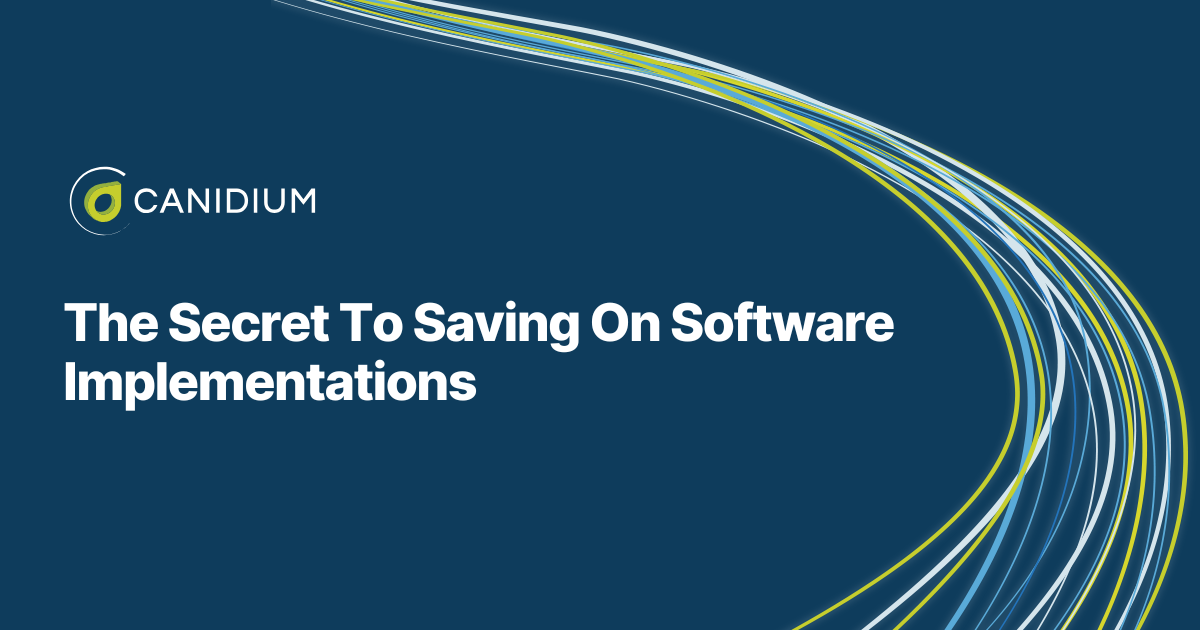Successfully implementing an organizational change, whether it is a process alteration or a new solution implementation, is more manageable if leadership and the workforce are on the same page. However, employee resistance to change often creates a gap between the strategies of the C-suite and the office floor.
At Canidium, we oversee complex solution implementation projects for organizations across industries. We help companies manage change before, during, and after their project. Leveraging our expertise, this guide explains employee resistance to change and offers a roadmap to overcoming it.
- What causes employee resistance to change?
- Building a communication plan: how to overcome employee resistance to change
- How to develop a change management strategy
What Causes Employee Resistance to Change
In 2016, the average employee experienced two planned enterprise changes; in 2022, they underwent five times that figure. The rapid pace of change in modern business environments is hard on employees. However, organizations are under increasing pressure to adapt to new technologies, shifting market trends, and globalization. This creates a fundamental dichotomy between employees and senior leaders.
Overall, 70% of change programs fail to achieve their goals, in part because of employee resistance to change. On the other hand, 72% of projects with extremely effective sponsors meet or exceed their objectives. These figures suggest that project managers and organizational leadership have the capacity to make or break the success of change within an organization. Yet, most of the time, leadership falls short in this area.
The introduction of new tools and processes within an organization often benefits the very same employees who resist their implementation. Their objections are often caused by uncertainty or unwillingness to upskill rather than problems with the tool or process itself.
Uncertainty can come in many forms; some employees may be concerned about their job stability in the age of AI, while others may simply experience stress due to their changing roles. At the same time, employees may resist learning how to use a new tool or navigate changing workflows not due to laziness (as sometimes assumed) but because they have spent countless hours perfecting their current processes and may feel all that work is thrown out the window by the introduction of a new tool. Moreover, they may be concerned that the efficacy of the new tool or processes will not match the level of nuance their current process accounts for.
In short, employee resistance to change is often rooted in a fear of the unknown, compounded by the potential ramifications they may directly experience in their role.
Studies have found that uncertainty surrounding roles and responsibilities creates an unproductive psychological burden on your employees, resulting in distrust in leadership and increased intent to quit. Luckily, the root cause of uncertainty among your workforce is easily diagnosable. A lack of communication and reassurance from leadership and management feeds employee resistance to change. Without a clear understanding of the impetus for the change, the process that will take place, and the ultimate benefits of the change for your workforce, speculation surrounding why you are making a change or potentially overlooked consequences can run rampant.
To craft an effective communication plan, you first need to understand each department's concerns. Simply attributing all resistance to uncertainty is not specific enough to adequately address employee concerns in your communication plan. You will need to get to the root of what each department or individual role is concerned about and speak directly to that concern.
Here is a breakdown of key stakeholders' common concerns during Canidium's pricing solution implementations. Note how each department's concerns are slightly different. When you begin to craft your change communication strategy, you will need to understand the nuances of your workforce's concerns.

Resistance to Solution Changes in Your IT Department
IT teams often operate under the principle of maintaining system stability and reliability, viewing changes with a critical eye. This skepticism is partly due to the extra workload that modifications in IT systems entail, particularly when these changes involve integrating with or exporting data to third-party applications. The underlying reluctance can be summed up by the common refrain in IT circles: "Our systems work fine. Why do we need to change?" This resistance is not just about the work involved but also about the risk of disrupting a well-tuned system without clear benefits.
Pricing Team Resistance to Process Disruptions
The resistance from pricing teams usually stems from the disruption of their established processes. Many pricing teams rely on a blend of databases, analytics, and Excel spreadsheets interwoven with email communications. While potentially cumbersome and manual, this method is familiar and has been proven effective over time. The notion of altering these processes can be daunting because it threatens the familiarity and predictability of their workflow. For example, even if pushing a price change takes two months, the team has mastered the intricacies of this process through repeated execution.
Sales Team Resistance to Relearning New Workflows
Resistance among sales teams often centers on the impact of new technologies on their daily routines, particularly in areas like quotes and contracts. Sales professionals, ranging from novices to veterans with decades of experience, may view new systems as unnecessary complications. There is also a significant element of control at play; sales teams frequently prefer to manage their pricing and negotiation processes discreetly. This autonomy allows them to tailor deals in ways that might not be possible under a more transparent system facilitated by advanced pricing tools. This preference for opacity can lead to resistance, as transparent processes could expose their negotiation tactics and pricing strategies.
Building a Communication Plan: How to Overcome Employee Resistance to Change
Once you have a detailed understanding of what concerns your employees have about your proposed change, your next step is to create an effective communication plan to resolve their uncertainties. This message may come from project management or business executives, whoever is most suited to sell the benefits of the change.
It is essential to tailor the message to each employee or team's specific concerns. For instance, if you address your sales team's concerns but neglect those of your IT department, you will still face resistance from the group with lingering uncertainty.
To demonstrate how to craft a tailored communication plan, let's examine how we would address the concerns of each employee group from our pricing solution implementation project.
.png?width=1920&height=1080&name=Three%20Stakeholder%20Concerns%20During%20Pricing%20Solution%20Implementations%20(1).png)
Practicing Effective Communication With IT
When communicating with the IT department about new pricing projects, it's vital to highlight the direct benefits these changes will bring to the organization's data management. Introducing a new pricing solution is not just about changing systems; it's about significantly enhancing data accuracy across customer and product databases. With more stakeholders entering and using data within the new application, the consistency and quality of the data are improved, leading to better decision-making capabilities organization-wide.
Key Points to Communicate:
- Better Data Quality: Explain how the pricing project will lead to more accurate and reliable data on customers, products, and other master data elements.
- Acknowledgment of Extra Effort: Recognize openly that integrating new systems will initially require additional effort from the IT team. Emphasize that this investment is worthwhile for the long-term benefits of improved data management.
- Enhanced Organizational Efficiency: Stress that better data quality directly contributes to more efficient operational processes, reducing errors and saving time in the future.
Reassuring Your Pricing Team
The introduction of a new pricing tool should be presented to the pricing team as an opportunity to reduce their workload and increase the value of their contributions to the company. By automating routine tasks, the team can shift their focus from tedious data manipulation to more strategic activities like analysis and decision-making, which are crucial for driving business results.
Key Points to Communicate:
- Workload Reduction: Highlight how the new system will automate routine tasks, allowing pricing team members to spend less time on manual data entry and spreadsheet management.
- Opportunity for More Strategic Work: Emphasize that with the time saved, the team can engage in more meaningful analysis and provide insights that have a tangible impact on the company's pricing strategies and profitability.
- Enhancement of Role Value: Discuss how these changes elevate the team's role, positioning them as key contributors to the company's success.
Highlighting the Benefits to Your Sales Team
Your communication plan for the sales team should focus on how the new pricing tools can help them close more deals and enhance their profitability. Better access to accurate pricing information and streamlined quote and contract processes will empower sales representatives to offer competitive and compelling proposals to prospects and customers.
Key Points to Communicate:
- Increased Deal-Closing Potential: Detail how quicker access to accurate pricing data will help salespeople respond more effectively to customer needs and market dynamics, thereby increasing their chances of winning deals.
- Enhanced Earning Potential: Explain how better pricing tools enable salespeople to optimize pricing strategies, potentially leading to higher commissions through more lucrative deals.
- Improved Customer Interactions: Highlight how streamlined processes and transparency can enhance customer trust and satisfaction, leading to stronger relationships and repeat business.
How to Develop a Change Management Strategy
Your communication plan is foundational to the success of the change management process. Still, it is not the only strategy you will need to implement to see the project through. Developing a comprehensive change management plan ahead of time can ensure that the integration of a new tool or process runs smoothly, increasing both your employees' trust in your management team and the value of the change.
.png?width=1920&height=1080&name=Three%20Stakeholder%20Concerns%20During%20Pricing%20Solution%20Implementations%20(2).png)
Foster Two-Way Communication
Often, employees who are most directly impacted by an organizational change have the least amount of say in the process. Your employees may become frustrated if they feel unheard in the design or implementation of a new solution they will be using. Effective change management hinges on transparent and ongoing communication. Encouraging two-way communication ensures employees feel heard and involved in the change process.
Develop a communication channel that facilitates feedback from employees regarding the nuances of the change. This will give you insight into the nature of their uncertainties, thus allowing you to better address them. It will also potentially generate insights into existing workflows that can be leveraged when designing and configuring your solution.
"Findings reveal that while adequate change communication is linked to increased job crafting behaviors for promotion-focused employees, inadequate change communication is linked to increased job crafting behaviors for prevention-focused employees." - Crafting the Change: The Role of Employee Job Crafting Behaviors for Successful Organizational Change
Ease Employee Concerns About Job Security
Job security is often one of the biggest concerns employees have when your organization implements new technology, and this issue can impact the whole company. Studies have established that job insecurity leads to poor performance.
Your employees are invested in your company's success when they believe you are invested in theirs. This means engagement decreases if concerns about your long-term investment in their role are present.
Take the time to communicate with your team about the ongoing value of their position within the organization. Relay that the change you are making is ultimately an investment in their role, giving them a tool or process that increases their value to the organization.
Leverage Your Software Implementation Partner's Experience
If you are working with a software implementation (SI) partner to design, configure, and integrate a new digital solution, leverage their expertise to smooth the transition between the old and new systems. SI partners have a wealth of experience guiding companies through transitions, providing technical expertise and strategic advice on handling change effectively.
Your SI partner also has solution-specific expertise. They already have detailed insight into your employees' potential concerns when implementing your new solution. They can help you explain how the change positively impacts different departments. At the same time, your partner can help provide training and support that allows employees to quickly adapt to the new system.
Put simply, beyond the technical aspects of implementing the new solution, which takes up most of an SI partner's role, they can provide "light touch" guidance and insights based on extensive experience with similar projects, which can be more effective than what companies might manage on their own.
Understanding Employee Resistance To Change and Effectively Communicating Your Management Strategy
Employee resistance to change often stems from a psychological fear of the unknown and practical concerns about new workflows and job security. As such, a comprehensive change management strategy is vital. This involves fostering open and two-way communication, where employees' fears can be addressed directly, and their input can be integrated into the change process. Senior leaders play a critical role in supporting this initiative by being actively involved and providing reassurance about job security and the benefits of change. Moreover, leveraging the expertise of software implementation partners can provide additional support and insights, enhancing the transition experience and ensuring a smoother integration of new tools and processes. In this regard, good project management is vital during the software implementation process. Check out this project management strategies guide to learn more.








